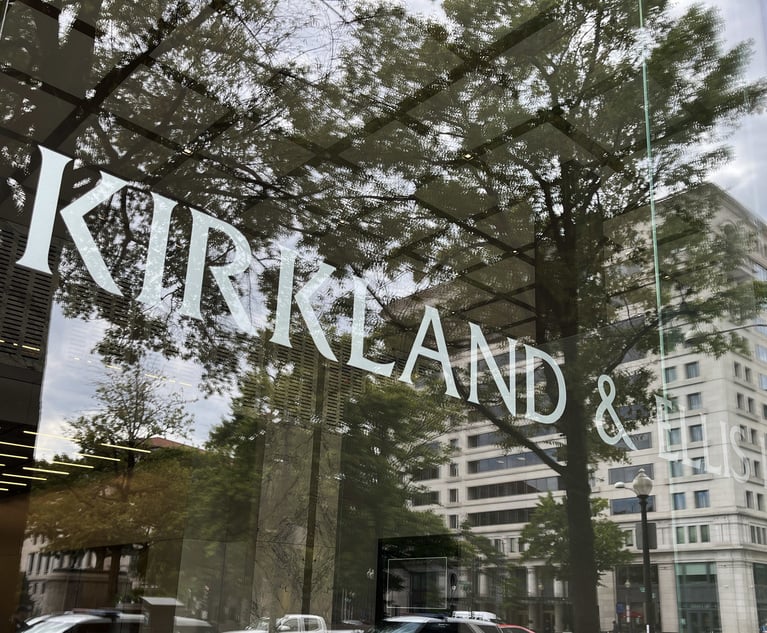Lessons for Big Law Spinoffs (We've Seen This Before)
Lawyers who recently left Big Law to found their own specialty firms say they aim to break the mold. Others started the same way...
March 08, 2018 at 01:17 PM
8 minute read

When the newly formed firm Selendy & Gay officially launched in New York last month, its founders—star litigators from Quinn Emanuel Urquhart & Sullivan—said they wanted to break from the traditional law firm model by changing a myriad of conventions. They said they would alter fee structures, change the way in which young lawyers are trained, and hire industry experts who would offer insights into their clients' businesses.
“It's a rare thing for 10 partners of this stature to come together, and we feel there's a space for this,” one of those founders, Philippe Selendy, said in February as the firm was getting underway.
Rare, yes. But among the small universe of high-end litigation specialists, it is not unprecedented.
Selendy and co-founder Faith Gay announced their move about two years after Beth Wilkinson and Alexandra Walsh—lawyers with burnished reputations as top litigators at Paul, Weiss, Rifkind, Wharton & Garrison—joined with former Munger, Tolles & Olson lawyer Sean Eskovitz to start Wilkinson Walsh + Eskovitz in early 2016.
And those recent spinoffs also had forerunners—people such as David Boies, who in 1997 left Cravath, Swaine & Moore, and Jonathan Schiller, who quit Kaye Scholer, to create the firm that is now Boies Schiller Flexner. Prior to that, in 1993, Fred Bartlit Jr. and Phil Beck led a group departure from Kirkland & Ellis and started the firm that is now Bartlit Beck Herman Palenchar & Scott. And in the mid-1980s, John Quinn left Cravath with the idea of creating a litigation-only firm that grew into Quinn Emanuel, an Am Law 100 firm that has now, in light of the Selendy & Gay launch, experienced its own spinoff.
In each case, firm leaders at these spinoffs, both old and new, held similar early-stage ambitions. They wanted to break from the traditional large firm mold; they wished to take on more cases and work on those that truly interested them; they hoped to adopt flexible fee structures wherever possible; and they planned to pay it forward by giving younger lawyers a chance to develop.
Similar ambitions do not mean similar results, however. The stories of Boies Schiller and Bartlit Beck, two successful firms that spun off from established Big Law institutions within a few years of each other, demonstrate that alike ambitions can lead to different outcomes. The tale of their respective paths sheds light and offers lessons for future Big Law breakaways.
Embracing Growth
Boies Schiller chairman Boies said he started his firm with the idea of establishing a boutique. Among other early goals, he said he wanted to build a different kind of business model. “I wanted to emphasize alternative fee arrangements that fit the needs of the client and gave us an incentive to be super efficient,” he said.
He and Schiller also set off from their prior firms with a desire to “do very, very high-quality legal work and to take on interesting cases, cases that pushed the law, particularly in areas that we thought were important for the justice system,” Boies said.
But staying small and taking on big cases, Boies learned, were not always compatible goals and could not always be pursued simultaneously. So Boies Schiller grew. The law firm that started out as a boutique now consists of more than 300 lawyers.
“When an interesting or important case came along—and in the early days we had a lot of them—we just didn't have the discipline to say no enough to stay small,” Boies said.
And, as the years went on, Boies said he came to recognize that growing beyond what he and Schiller had planned at the outset had its benefits. For one, a larger firm made it easier to have cases at various stages of development at any given time, allowing for “continuity and a reasonable revenue stream.” He also pointed to an upside in the realm of succession planning and establishing an institution that could outlive its founders.
“A law firm that has the same number of lawyers year over year, and is not growing, is a law firm that doesn't have a good time horizon beyond the tenure of the lead lawyers that are there,” he said. “There's a necessary component of growth if you're going to continue to attract young lawyers. And that's the lifeblood of any continuing law firm.”
Staying Small
Bartlit Beck, meanwhile, followed a different trajectory. Like Boies, its leaders started out wanting to eschew billable hours in favor of flat fees with a bonus for winning, and with an aim of staying small. And, even more so than Boies' firm, Bartlit Beck inverted the typical staffing model: Instead of putting large numbers of associates on a case, as is typical at many large firms, Bartlit Beck staffed its cases primarily with partners.
To keep that system in place, the firm's leaders opted not to hire lateral partners. That kept the firm small and put a focus on developing talent among its young lawyers. But the reality of small, said founding partner Beck, meant exercising a significant amount of discipline, including turning away potential clients and saying no to overtures from larger firms for possible mergers.
“We have been committed from day one to stay as small as we can and still provide the quality service that our clients want,” Beck said.
From the outset, Beck fully expected that Bartlit Beck would do well in the courtroom. But he said he didn't fully appreciate at first the ways in which staying small and refraining from lateral hiring would benefit the up-and-comers in the firm.
“We've actually institutionalized the ethic that giving opportunities and responsibility to younger lawyers is the highest achievement that you can attain at the firm,” Beck said.
Pursuing Ambition in a Modern Age
The sustained existence of those earlier Big Law breakaways means the newer batch, such as Wilkinson Walsh and Selendy & Gay, do not have to paint on a blank canvas.
Wilkinson and Walsh have said the idea behind their launch was to build a firm designed for trial work—one that would also provide ample opportunities for young lawyers to gain meaningful experience. The two firm founders stressed that in pursuit of those goals, they opted for a financial model that avoids billing by the hour and attempts to keep their lawyers' compensation at comparable levels to their colleagues'.
A few years in, the benefits of that approach have been two-fold, according to Wilkinson. It has created incentives for lawyers to share work and has tamped down on competition among associates at the firm.
“We don't want to have a lot of competition where in the end you're not working for the client,” she said. “Because of our financial model, the senior people like me are not trying to hold on to the business.”
Walsh added that adopting a billing method that often includes “success fees”—in which a client pays more for a win—further aligns the firm's interests with those of its clients'.
“As trial lawyers,” she said, “we want to win no matter what. Part of it is showing the client that and that you have some skin in the game.”
The ambitions of Wilkinson Walsh's founders, with their focus on training younger lawyers, adopting alternative fee arrangements, and staying relatively small, have a familiar ring. And both of the firm's founders acknowledged that earlier spinoffs offered them a measure of inspiration.
“Yes,” Wilkinson said. “They're inspiring because Big Law sometimes makes you feel like you can't do it without the machine.”
But with each generation comes something new. Wilkinson pointed out that a key difference between some of the earlier firms and Wilkinson Walsh is that her firm, in addition to training a younger generation, strives to maintain true diversity.
“No women were running those firms,” she said.
That, in its own way, provided another level of motivation—giving Walsh and Wilkinson an opportunity to demonstrate that women and minority lawyers could succeed not just in the realm of Big Law, but also as the heads of their own firm.
“To have me and Alex go out to do it,” Wilkinson said, “it was meaningful to us to show ourselves—and our daughters.”
This content has been archived. It is available through our partners, LexisNexis® and Bloomberg Law.
To view this content, please continue to their sites.
Not a Lexis Subscriber?
Subscribe Now
Not a Bloomberg Law Subscriber?
Subscribe Now
NOT FOR REPRINT
© 2025 ALM Global, LLC, All Rights Reserved. Request academic re-use from www.copyright.com. All other uses, submit a request to [email protected]. For more information visit Asset & Logo Licensing.
You Might Like
View All
Kirkland Is Entering a New Market. Will Its Rates Get a Warm Welcome?
5 minute read

Why Associates in This Growing Legal Market Are Leaving Their Firms

Trending Stories
Who Got The Work
J. Brugh Lower of Gibbons has entered an appearance for industrial equipment supplier Devco Corporation in a pending trademark infringement lawsuit. The suit, accusing the defendant of selling knock-off Graco products, was filed Dec. 18 in New Jersey District Court by Rivkin Radler on behalf of Graco Inc. and Graco Minnesota. The case, assigned to U.S. District Judge Zahid N. Quraishi, is 3:24-cv-11294, Graco Inc. et al v. Devco Corporation.
Who Got The Work
Rebecca Maller-Stein and Kent A. Yalowitz of Arnold & Porter Kaye Scholer have entered their appearances for Hanaco Venture Capital and its executives, Lior Prosor and David Frankel, in a pending securities lawsuit. The action, filed on Dec. 24 in New York Southern District Court by Zell, Aron & Co. on behalf of Goldeneye Advisors, accuses the defendants of negligently and fraudulently managing the plaintiff's $1 million investment. The case, assigned to U.S. District Judge Vernon S. Broderick, is 1:24-cv-09918, Goldeneye Advisors, LLC v. Hanaco Venture Capital, Ltd. et al.
Who Got The Work
Attorneys from A&O Shearman has stepped in as defense counsel for Toronto-Dominion Bank and other defendants in a pending securities class action. The suit, filed Dec. 11 in New York Southern District Court by Bleichmar Fonti & Auld, accuses the defendants of concealing the bank's 'pervasive' deficiencies in regards to its compliance with the Bank Secrecy Act and the quality of its anti-money laundering controls. The case, assigned to U.S. District Judge Arun Subramanian, is 1:24-cv-09445, Gonzalez v. The Toronto-Dominion Bank et al.
Who Got The Work
Crown Castle International, a Pennsylvania company providing shared communications infrastructure, has turned to Luke D. Wolf of Gordon Rees Scully Mansukhani to fend off a pending breach-of-contract lawsuit. The court action, filed Nov. 25 in Michigan Eastern District Court by Hooper Hathaway PC on behalf of The Town Residences LLC, accuses Crown Castle of failing to transfer approximately $30,000 in utility payments from T-Mobile in breach of a roof-top lease and assignment agreement. The case, assigned to U.S. District Judge Susan K. Declercq, is 2:24-cv-13131, The Town Residences LLC v. T-Mobile US, Inc. et al.
Who Got The Work
Wilfred P. Coronato and Daniel M. Schwartz of McCarter & English have stepped in as defense counsel to Electrolux Home Products Inc. in a pending product liability lawsuit. The court action, filed Nov. 26 in New York Eastern District Court by Poulos Lopiccolo PC and Nagel Rice LLP on behalf of David Stern, alleges that the defendant's refrigerators’ drawers and shelving repeatedly break and fall apart within months after purchase. The case, assigned to U.S. District Judge Joan M. Azrack, is 2:24-cv-08204, Stern v. Electrolux Home Products, Inc.
Featured Firms
Law Offices of Gary Martin Hays & Associates, P.C.
(470) 294-1674
Law Offices of Mark E. Salomone
(857) 444-6468
Smith & Hassler
(713) 739-1250










